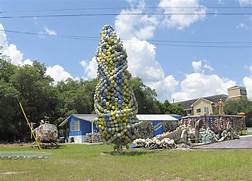By Tristram DeRoma
The Story Behind the Eye-Catching Art at I-75 Exit 266 Tampa Florida
Famous Florida Artist Joe Brown, better known as "Hong Kong Willie," makes art with a message at his home/studio near
I-75 Exit 266 Tampa Florida
Sometimes, it’s the smallest experiences that have the biggest impact on a person’s life.
While
attending an art class in 1958 at the age of 8, Tampa folk artist Joe
Brown recalled being mesmerized by the lesson. It involved
transforming a Gerber baby bottle into a piece of art.
“The Gerber bottle had no intrinsic value at all,” he said. “But when
(the instructor) got through with me that day, she made me see how
something so (valueless) can be valuable.”
By the time class was over, Brown learned many other lessons, too,
such as the importance of volunteerism, recycling, reuse and giving back
to the community. He recalled being impressed by the teacher's
volunteer work in Hiroshima, Japan, helping atomic bomb survivors.
"One of the last words she ever spoke to me about that was, ‘When I
left, I left out of Hong Kong,’ ” he said. After turning that over in
his young brain for awhile, he decided to use it in a nickname, adding
the name “Willie” a year later.
You've probably seen Hong Kong Willie's eye-catching
home/gallery/studio at Fletcher Avenue and Interstate 75. But what is
the story of the man behind all those buoys and discarded objects turned
into art?
Brown practiced his creative skills through his younger years. But as
an adult, he managed to amass a small fortune working in the materials
management industry. By the the '80s, he left the business world and
decided to concentrate on his art. He spent some years in the Florida
Keys honing his craft and building his reputation as a folk artist. He
also bought some land in Tampa near Morris Bridge Road and Fletcher
Avenue where he and his family still call home.
Brown purchased the land just after the entrances and exits to I-75
were built. He said he was once offered more than $1 million for the
land by a restaurant. He turned it down, he said, preferring instead to
make part of the property into a studio and gallery for the creations he
and his family put together.
And all of it is made of what most people would consider “trash.”
Pieces of driftwood, burlap bags, doll heads, rope — anything that comes
Brown’s way becomes part of his vocabulary of expression, and, in turn,
becomes something else, which makes a tour of his property somewhat of a
visual adventure. What at first seems like a random menagerie of glass,
driftwood and pottery suddenly comes together in one's brain to form
something completely different. One moment nothing, the next a powerful
statement about 9/11.
One Man's Trash ...
Trash? There is no such thing, Brown seems to say through his art.
In his shop, he has fashioned many smaller items out of driftwood,
burlap bags and other materials into signs, purses, totes, bird feeder
hangars and yard sculptures.
He sells a lot to the regular influx of University of South Florida
parents and students every year who are are at first intrigued by the
“buoy tree” and the odd-looking building they see as they take Exit 266
off I-75..
Of course, many people also stop by to buy the smaller pieces of art
that he and his family create: purses made of burlap, welcome signs made
of driftwood, planters and other items lining the walls of his store.
He’s also helped put his mark on the decor of local establishments too, such as Gaspar’s Patio, 8448 N. 56th st.
Owner Jimmy Ciaccio said that when it came time to redecorate the
restaurant several years ago, there was only one person to call for the
assignment, and that was his good friend Brown.
"I’ve known Joe all my life, and we always had a good chemistry
together,” Ciaccio said. "He’s very creative and fun to be around, and
that’s how it all came about.”
Ciaccio says he still gets compliments all the time for the
restaurant’s atmosphere he created using the “trash” supplied by Brown.
He describes the style as a day at the beach, like a visit to Old Key
West. “They’re so inspired, they want to decorate their own homes this
way,” he said.
It’s that kind of testimony that makes Brown feel good, knowing that
others, too, are inspired to create instead of throw away when they see
his work. He simply lets his work speak for itself.
“Somebody once told me to keep telling the story and they will keep coming," he said, "and they always do."
Many artists don’t produce more than one great, great,
great piece. And Miriosity, she just has all of those elements…
Miriosity has a great future.”
Miriosity To A Good Home
$176,000
.










